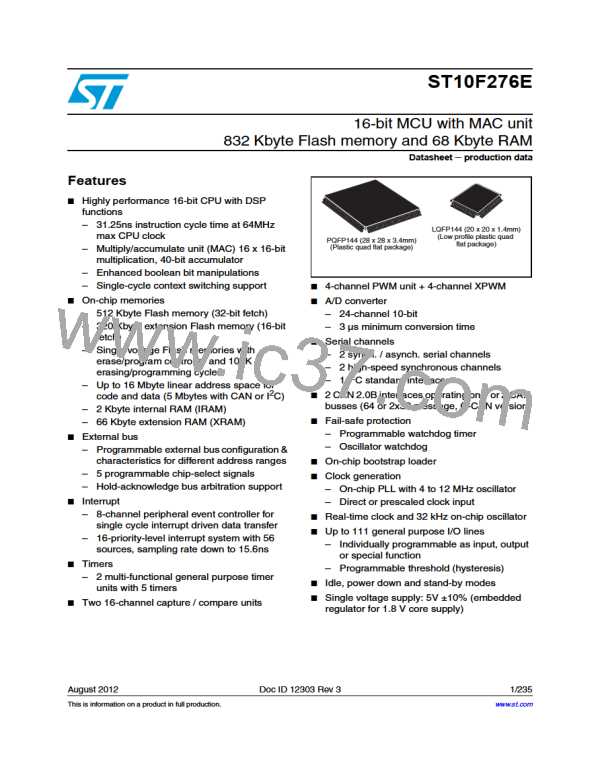ST10F276E
Parallel ports
12.2.2
Input threshold control
The standard inputs of the ST10F276E determine the status of input signals according to
TTL levels. In order to accept and recognize noisy signals, CMOS input thresholds can be
selected instead of the standard TTL thresholds for all the pins. These CMOS thresholds
are defined above the TTL thresholds and feature a higher hysteresis to prevent the inputs
from toggling while the respective input signal level is near the thresholds.
The Port Input Control registers PICON and XPICON are used to select these thresholds for
each Byte of the indicated ports, this means the 8-bit ports P0L, P0H, P1L, P1H, P4, P7 and
P8 are controlled by one bit each while ports P2, P3 and P5 are controlled by two bits each.
All options for individual direction and output mode control are available for each pin,
independent of the selected input threshold.
12.3
Alternate port functions
Each port line has one associated programmable alternate input or output function.
●
PORT0 and PORT1 may be used as address and data lines when accessing external
memory. Besides, PORT1 provides also:
–
–
Input capture lines
8 additional analog input channels to the A/D converter
●
Port 2, Port 7 and Port 8 are associated with the capture inputs or compare outputs of
the CAPCOM units and/or with the outputs of the PWM0 module, of the PWM1 module
and of the ASC1.
Port 2 is also used for fast external interrupt inputs and for timer 7 input.
●
●
Port 3 includes the alternate functions of timers, serial interfaces, the optional bus
control signal BHE and the system clock output (CLKOUT).
Port 4 outputs the additional segment address bit A23...A16 in systems where more
than 64 Kbytes of memory are to be access directly. In addition, CAN1, CAN2 and I2C
lines are provided.
●
●
Port 5 is used as analog input channels of the A/D converter or as timer control signals.
Port 6 provides optional bus arbitration signals (BREQ, HLDA, HOLD) and chip select
signals and the SSC1 lines.
If the alternate output function of a pin is to be used, the direction of this pin must be
programmed for output (DPx.y=‘1’), except for some signals that are used directly after reset
and are configured automatically. Otherwise the pin remains in the high-impedance state
and is not effected by the alternate output function. The respective port latch should hold a
‘1’, because its output is ANDed with the alternate output data (except for PWM output
signals).
If the alternate input function of a pin is used, the direction of the pin must be programmed
for input (DPx.y=‘0’) if an external device is driving the pin. The input direction is the default
after reset. If no external device is connected to the pin, however, one can also set the
direction for this pin to output. In this case, the pin reflects the state of the port output latch.
Thus, the alternate input function reads the value stored in the port output latch. This can be
used for testing purposes to allow a software trigger of an alternate input function by writing
to the port output latch.
On most of the port lines, the user software is responsible for setting the proper direction
when using an alternate input or output function of a pin.
Doc ID 12303 Rev 3
91/235

 STMICROELECTRONICS [ ST ]
STMICROELECTRONICS [ ST ]